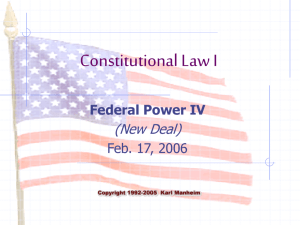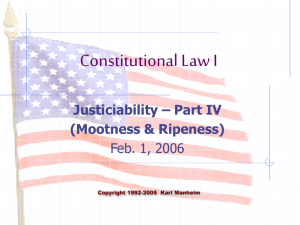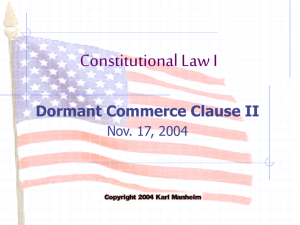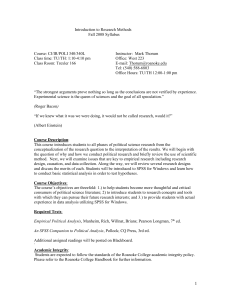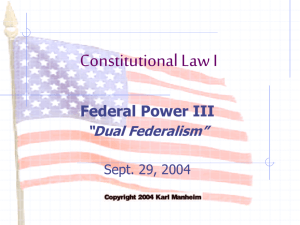PowerPoint Presentation - Introduction
advertisement
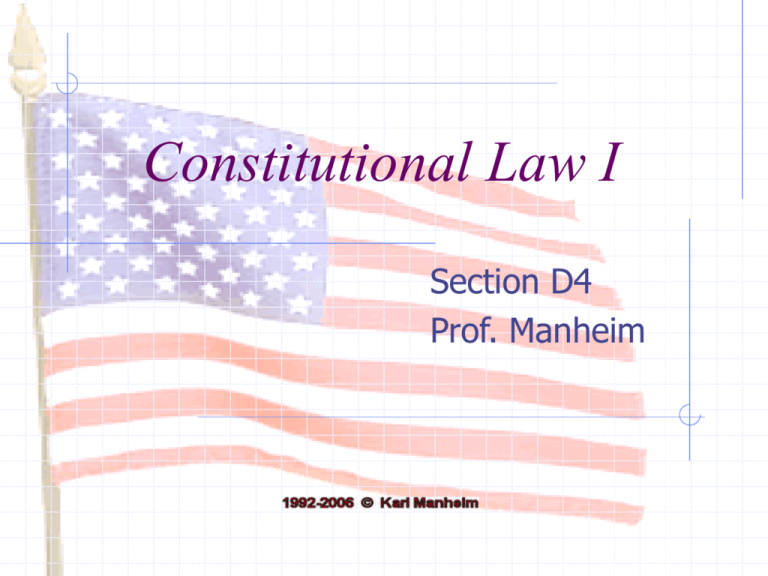
Constitutional Law I Section D4 Prof. Manheim Contact Info Office: Burns 348 Tel: 213-736-1106 Email: karl.manheim@lls.edu Web: http://classes.lls.edu/spring2006/conlaw-manheim Hours: Weds, 2:30-3:30 Spring, 2006 Con Law I - Manheim 2 Course Info Final Exam: 3 hr closed book 50% essay 50% objective (multiple choice) Class Participation Points 1 grade for in-class participation and class blog discussion Attendance, Recording, etc. Spring, 2006 Con Law I - Manheim 3 In the beginning … … there was the Crown Then chartered companies w/ gov’t power Then colonial governments Then State governments and the Continental Congress Then the Articles of Confederation and the Unites States of America in Congress Assembled Then the Constitution Spring, 2006 Con Law I - Manheim 4 Spring, 2006 Con Law I - Manheim 5 Our Constitution 2nd of 3 constitutions (+ 50 state const’s) Articles of Confederation (1781-1788) Unanimous consent required Each state with 1 vote No separate executive text Constitution of the Confederate States (1861) Modeled after the Federal Constitution Significant difference in states' rights text Spring, 2006 Con Law I - Manheim 6 Spring, 2006 Con Law I - Manheim 7 Astrological chart on Mar. 1, 1781 at Phil, PA Spring, 2006 Con Law I - Manheim 8 Spring, 2006 Con Law I - Manheim 9 Sovereignty passed from King George III to where? 13 Independent States ? The National Government ? The People ? See Treaty of Paris Spring, 2006 Con Law I - Manheim 10 The Federal Constitution Spring, 2006 Con Law I - Manheim 11 The United States in 1787 Spring, 2006 Con Law I - Manheim 12 Historical Anecdotes Only 6 of 56 signers of Declaration were in attendance Patrick Henry refused to attend “I smelt a rat” Spring, 2006 Con Law I - Manheim 13 Historical Anecdotes Only 6 of 56 signers of Declaration were in attendance Born of Original Sin Federalist vs. Anti-Federalist debate Who was the first President of the United States? Spring, 2006 Con Law I - Manheim 14 The Ratification Debates Federalist vs. Antifederalist Federalist Papers: To the People of the State of New York: AFTER an unequivocal experience of the inefficiency of the subsisting federal government, you are called upon to deliberate on a new Constitution for the United States of America. Hamilton, Federalist #1 Since “security could only be found in a national government more wisely framed, the [people] as with one voice, convened the late convention at Philadelphia, to take that important subject under consideration. Jay, Federalist #2 Spring, 2006 Con Law I - Manheim 15 Reinventing Government We the People of the United States, in Order to from a more perfect Union … Madison: Federalist 51 The Structure of the Government Must Furnish the Proper Checks and Balances Between the Different Departments Spring, 2006 Con Law I - Manheim 16 Reinventing Government “you must first enable the government to control the governed; and in the next place oblige it to control itself. A dependence on the people is, no doubt, the primary control on the government; but experience has taught mankind the necessity of auxiliary precautions” Spring, 2006 Con Law I - Manheim 17 Reinventing Government What are those auxiliary precautions? Structure: Divided powers Horizontally (among 3 branches of fed’l gov’t) Each distinctly constituted Vertically (between fed’l and state gov’t) Amendment Substance: Rights Original text: habeas corpus, contracts, slavery Bill of Rights (1791): speech, press, due process Spring, 2006 Con Law I - Manheim 18 A Course in Constitutional Law The Constitution as Political foundation Establishes and defines the federal gov't Creates a "Republican” form of Government Divides and limits the power of government Promotes individual liberty Affirms “Popular Sovereignty” The Constitution as Law Paramount, enforceable legal norms Break from monarchical gov’t (divine right) Rule of law vs. rule of men Spring, 2006 Non sub homine, sed sub deo et lege Con Law I - Manheim 19 Major Themes of Con Law I Judicial Review Power of courts to set aside laws & acts of political bodies (legislatures, executive) Federalism Distribution of power between states and federal government Separation of Powers Distribution of power among the 3 co-equal branches of the federal government Spring, 2006 Con Law I - Manheim 20 Judicial Review Power and role of Supreme Court Source of authority Countermajoritarian difficulty Interpretation Theories of Review Role of politics & ideology When review occurs Justiciability Political Questions Spring, 2006 Con Law I - Manheim 21 Federalism Power of Federal Government Enumerated powers Limited by state sovereignty Feds Power of States Limited by grant of power to federal government & express restriction Limited by existence of sister states Demi-sovereignty Inter-governmental Immunities Spring, 2006 Con Law I - Manheim States 22 Federalism Power of Federal Government Enumerated powers Limited by state sovereignty States Power of States Limited by grant of power to federal government & express restriction Limited by existence of sister states Demi-sovereignty Inter-governmental Immunities Spring, 2006 Con Law I - Manheim Feds 23 Separation of Powers Theory of Divided Government Diffusion of power to protect liberty 3 branches differently composed Interbranch usurpations Interbranch interference congress Spring, 2006 executive Con Law I - Manheim judicial 24 Separation of Powers Theory of Divided Government Diffusion of power to protect liberty 3 branches differently composed Interbranch usurpations Interbranch interference executive congress Spring, 2006 judicial Con Law I - Manheim 25 Structure of the Constitution By History & Context Pre-existence of states By Article I II III IV V VI Spring, 2006 Legislative Department Executive Department Judicial Department Inter-State Relations Amendment Supremacy Con Law I - Manheim 26 Spring, 2006 Con Law I - Manheim 27 Spring, 2006 Con Law I - Manheim 28 Major Historical Periods Pre-constitutional Colonial & revolutionary periods (17th C -1781) Formational (Articles; Ratification) (1781-1790) Federalist Era (1790 - 1801) Antebellum (1801 - 1860) Jay Marshall Taney Reconstruction (1865 - 1883) Dual Federalism (1883 - 1937) Chase Fuller Taft Hughes New Deal (1937 - 1990) Stone Warren States’ Rights (1990 - ) Rehnquist Roberts Spring, 2006 Con Law I - Manheim 29 Constitutional Conflicts Federal vs. State Structure vs. Rights Majoritarianism vs. Individualism Interpretivism Textualism, Originalism, Dynamic Meaning, Non-Interpretivism (external sources) Spring, 2006 Con Law I - Manheim 30 Hot Topics States Rights Civil Rights War & Foreign Relations Presidential Powers Supreme Court Website Spring, 2006 Con Law I - Manheim 31
